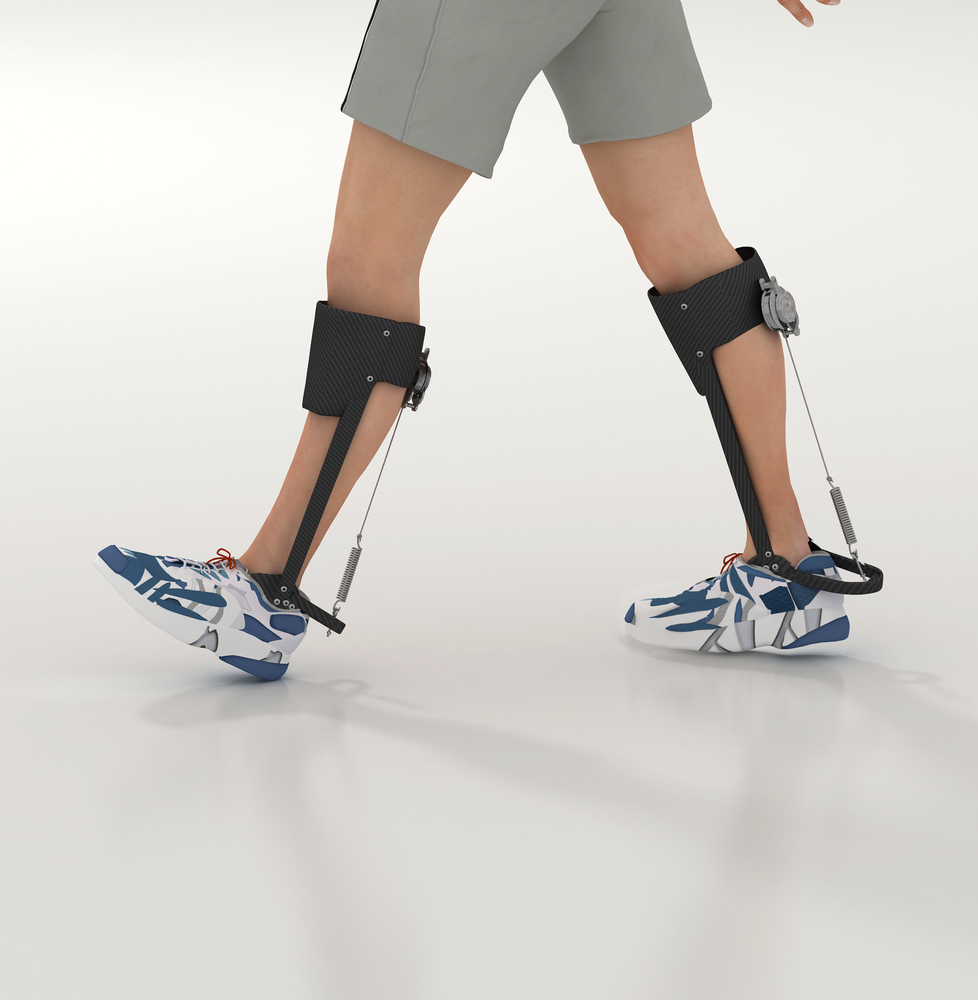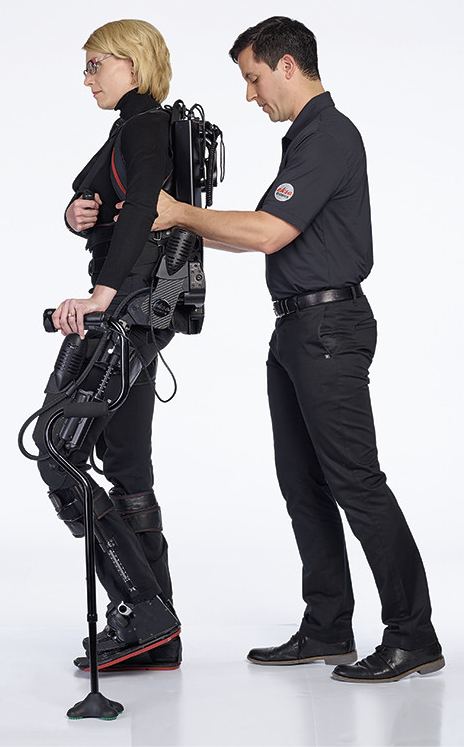Completely Paralyzed Man Voluntarily Moves His Legs, Takes Thousands Of Steps

Almost 6 million Americans are living with some form of paralysis, including nearly 1.3 million who have suffered spinal cord injuries. However, a team of University of California at Los Angeles (UCLA) scientists reports this week that a 39-year-old man who has been completely paralyzed for four years was able to voluntarily control his leg muscles and take thousands of steps in a robotic exoskeleton device during five days of training and for two weeks thereafter.
The scientists say this is the first time a person with chronic, complete paralysis has regained enough voluntary control to actively work with a robotic device designed to enhance mobility, aided by a novel noninvasive spinal stimulation technique that does not involve surgery. The subject’s leg movements also resulted in other health benefits, including improved cardiovascular function and muscle tone.
The innovative technology combines a battery-powered wearable bionic suit that enables wearers to move their legs in a step-like fashion, with a noninvasive procedure that the same researchers had previously used to enable five men who had been completely paralyzed to move their legs in a rhythmic motion. That earlier achievement is believed to be the first time people who are completely paralyzed have been able to relearn voluntary leg movements without undergoing surgery. The researchers choose not to refer to the achievement as walking, because no completely paralyzed person has independently walked unaided by the robotic device and electrical stimulation of the spinal cord.
In this most recent study, the UCLA scientists treated a patient named Mark Pollock, who lost his sight in 1998 and later became the first blind man to race to the South Pole. In 2010, Mr. Pollock also suffered a spinal cord injury in a fall from a second-floor window and that left him paralyzed from the waist down.
After receiving a few weeks of physical training At UCLA without spinal stimulation, Mr. Pollock had made substantial progress, which was followed-up with just five days of spinal stimulation training in a one-week span, each session taking about an hour a day.
“In the last few weeks of the trial, my heart rate hit 138 beats per minute,” Mr. Pollock told UCLA Newsroom’s Stuart Wolpert. “This is an aerobic training zone, a rate I haven’t even come close to since being paralyzed while walking in the robot alone, without these interventions. That was a very exciting, emotional moment for me, having spent my whole adult life before breaking my back as an athlete.”
Even in the years since he lost his sight, Mark Pollock has remained an inspirational overachiever, having competed in ultra-endurance races across deserts, mountains and the polar ice caps. He also won silver and bronze medals in rowing at the Commonwealth Games and launched a motivational speaking business.
“Stepping with the stimulation and having my heart rate increase, along with the awareness of my legs under me, was addictive. I wanted more,” he observes in the UCLA release.
The research was published by the IEEE Engineering in Medicine and Biology Society, the world’s largest society of biomedical engineers, in a paper entitled “Iron ‘ElectriRx’ Man: Overground Stepping in an Exoskeleton Combined with Noninvasive Spinal Cord Stimulation after Paralysis” Lead author of the paper is UCLA research scientist Parag Gad. Lead co-authors were Yury Gerasimenko, director of the laboratory of movement physiology at Russia’s Pavlov Institute and a researcher in the UCLA department of integrative biology and physiology; and Dr. Daniel Lu, associate professor of neurosurgery in UCLAs David Geffen School of Medicine. Other key UCLA contributors were research technician Sharon Zdunowski, researchers Dimitry Sayenko and Roland Roy, research associate Piia Haakana and Amanda Turner — coordinator of the Dr. V. Reggie Edgerton laboratory at UCLA.
The coauthors explain “We asked whether coordinated voluntary movement of the lower limbs could be regained in an individual having been completely paralyzed (>4 yr) and completely absent of vision (>15 yr) using a novel strategy – transcutaneous spinal cord stimulation at selected sites over the spinal vertebrae with just one week of training. We also asked whether this stimulation strategy could facilitate stepping assisted by an exoskeleton (EKSO, EKSO Bionics) that is designed so that the subject can voluntarily complement the work being performed by the exoskeleton. We found that spinal cord stimulation enhanced the level of effort that the subject could generate while stepping in the exoskeleton. In addition, stimulation improved the coordination patterns of the lower limb muscles resulting in a more continuous, smooth stepping motion in the exoskeleton.
The investigators say that based on the data from this case study there appears to be considerable potential for positive synergistic results after complete paralysis by combining the overground stepping in an exoskeleton, a novel transcutaneous spinal cord stimulation paradigm, and daily training.
“It will be difficult to get people with complete paralysis to walk completely independently, but even if they dont accomplish that, the fact they can assist themselves in walking will greatly improve their overall health and quality of life,” observes V. Reggie Edgerton, senior author of the research paper and a UCLA distinguished professor of integrative biology and physiology, neurobiology and neurosurgery.
The UCLA procedure used a robotic device manufactured by Richmond, California-based Ekso Bionics which captures data that enables the research team to determine how much the subject is moving his own limbs, as opposed to being aided by the device.
“If the robot does all the work, the subject becomes passive and the nervous system shuts down,” Dr. Edgerton points out. (Photo credit: Reed Hutchinson/UCLA)
Ekso describes its product as a wearable bionic suit that enables individuals with any amount of lower extremity weakness to stand up and walk over ground with a natural, full weight bearing, reciprocal gait. Walking is achieved by the user’s weight shifts to activate sensors in the device which initiate steps. Battery-powered motors drive the legs, replacing deficient neuromuscular function, and enabling people with as much as complete paralysis, and minimal forearm strength, to stand and walk.
Photo courtesy Ekso Bionics
The Ekso GT robotic exoskeleton provides functional based rehabilitation, over ground gait training, and upright, weight bearing exercise under the supervision of a physical therapist, and has been designed tomaccomodate the needs of busy therapists treating a wide range of patients in a single day. The suit is strapped over the users´ clothing with easy adjustments to transition between patients in as little as five minutes.
The research data showed that Mr. Pollock was actively flexing his left knee and raising his left leg, and that during and after the electrical stimulation, he was able to voluntarily assist the robot during stepping; so it wasn’t just the robotic device doing the work.
“For people who are severely injured but not completely paralyzed, there’s every reason to believe that they will have the opportunity to use these types of interventions to further improve their level of function,” says Dr. Edgerton “They’re likely to improve even more, [and] we need to expand the clinical toolbox available for people with spinal cord injury and other diseases.”
Dr. Edgerton and his research team at UCLA have received many awards and honors for their research, including the Popular Mechanics 2011 Breakthrough Award.
Dr. Edgerton’s laboratory focuses on two main research questions:
1) How do the neural networks in the lumbar spinal cord of mammals, including humans, regain control of standing, stepping and voluntary control of fine movements after paralysis?
2) How can these motor functions be modified by imposing activity-dependent interventions after spinal cord injury?
“Two general questions are being studied in my lab,” says Dr. Edgerton. “One is, how, and to what extent, does the nervous system control protein expression in skeletal muscle fibers? These studies have shown that although the nervous system has a significant influence on the kind and amount of specific proteins synthesized, there are factors intrinsic to individual fibers that also define these properties. The results show also that the neural influence that is associated with muscle fiber types is probably not mediated via the amount or pattern of activity of the motor units. Whole muscle, single motor units and single muscle fibers are studied physiologically and biochemically….
“My lab has a very multidisciplinary and integrative approach to science. It involves techniques to assess the kinetics and kinematics of locomotion, the activation patterns of those motor pools that generate the movement and the segmental and sensory networks that modulate the output of these motor pools. In our experiments we also study cell and tissue properties (nerve and muscle) that are important in generating the behavioral characteristics observed.
“Over a period of decades of animal and human experiments we have been able to develop and demonstrate the efficacy of several types of interventions generally categorized as neuromodulatory interventions. These neuromodulatory interventions involve the activation of the spinal networks appropriately after injury. This activation can be enabled by electrical stimulation of the spinal cord applied epidurally (surgically implanted electrodes) or transcutaneously (electrodes placed on the skin) and by pharmacological interventions. The effectiveness of these methods of facilitating recovery of function of spinal networks is dependent on highly specialized rehabilitation procedures. The reason for the importance of sensorimotor training of spinal networks that have been awakened from a dormant stage is that the spinal networks actually learn the motor skills that it practices.”
The researchers now have three effective ways to neuromodulate the spinal cord to improve and regain function:
1) Stimulation of the spinal circuitry using electrical current: Invasive and Non-Invasive
2) Administration of pharmacological agents
3) Repetitive training of motor tasks.
The different methods for neuromodulation of the spinal circuitry are also being tested with respect to their efficacy in improving function of the arms and hands, improved ventilatory function to regain mechanical ventilation dependents, recovering a more normal gait pattern after stroke and improve motor function in individuals with Parkinson’s Disease, and the lab’s research team are actively pursuing strategies directed toward restoring bladder function after spinal cord injury.
 “Dr. Edgerton is a pioneer and we are encouraged by these findings to broaden our understanding of possible treatment options for paralysis,” says Peter Wilderotter, president and CEO of the Christopher and Dana Reeve Foundation, which helped fund the UCLA research, in the UCLA release. “Given the complexities of a spinal cord injury, there will be no one-size-fits-all cure but rather a combination of different interventions to achieve functional recovery. What we are seeing right now in the field of spinal cord research is a surge of momentum with new directions and approaches to remind the spine of its potential even years after an injury.”
“Dr. Edgerton is a pioneer and we are encouraged by these findings to broaden our understanding of possible treatment options for paralysis,” says Peter Wilderotter, president and CEO of the Christopher and Dana Reeve Foundation, which helped fund the UCLA research, in the UCLA release. “Given the complexities of a spinal cord injury, there will be no one-size-fits-all cure but rather a combination of different interventions to achieve functional recovery. What we are seeing right now in the field of spinal cord research is a surge of momentum with new directions and approaches to remind the spine of its potential even years after an injury.”
 Grace Peng, director of NIBIB’s Rehabilitation Engineering Program, observes that “This is a great example of a therapeutic approach that combines two very different modalities neuromodulation and robotic assist devices to achieve a result that could not be realized with either approach alone. This multi-device approach, much like multi-drug therapy, may ultimately benefit patients with impaired mobility in a wide variety of rehabilitation settings.”
Grace Peng, director of NIBIB’s Rehabilitation Engineering Program, observes that “This is a great example of a therapeutic approach that combines two very different modalities neuromodulation and robotic assist devices to achieve a result that could not be realized with either approach alone. This multi-device approach, much like multi-drug therapy, may ultimately benefit patients with impaired mobility in a wide variety of rehabilitation settings.”
The Rehabilitation Engineering program supports next generation engineering technology for rehabilitation engineering research. Application areas include early stage technology development of neuroprosthesis and neuroengineering systems, Brain Computer Interface (BCI) technology, robotics for rehabilitation, bio-mechanics of human movement. Specific technologies include the development of intelligent hardware and software for the control of devices and the prediction of physiological signals and human behavior.
NeuroRecovery Technologies, a medical technology company founded by Dr. Edgerton, designs and develops devices that help restore movement in patients with paralysis, and provided the device used to stimulate the spinal cord in combination with the Ekso in this research. Through efforts of combined research, the NeuroRecovery team has achieved results that have placed them at the forefront of advancing the recovery and rehabilitation of spinal cord injury patient, and is being peer-credited with accomplishing a remarkable medical breakthrough, with initial clinical evaluation revealing the ability of NeuroRecovery Technologies’ patent pending technology and method of approach to restore voluntary movement and independent standing, along with varying degrees of restored function to bladder & bowel control, temperature regulation, blood pressure and sexual function in nearly 20 subjects with complete or partial paralysis.
Dr. Edgerton notes that although it likely will be years before the new approaches are widely available, he believes it is possible now to significantly improve quality of life for patients with severe spinal cord injuries, and help them recover multiple body functions, but that although his laboratory is making dramatic progress, it only is able to work with a small number of patients due to limited resources.
“We could accomplish a lot more in advancing the science and technology with more resources,” he observes.
In addition to the Reeve foundation, this research was funded by the National Institutes of Health’s National Institute of Biomedical Imaging and Bioengineering (grants U01EB15521 and R01EB007615), the F. M. Kirby Foundation, the Walkabout Foundation, the Dana and Albert R. Broccoli Foundation, Ekso Bionics, NeuroRecovery Technologies and the Mark Pollock Trust.
Sources:
University of California at Los Angeles (UCLA)
IEEE Engineering in Medicine and Biology Society
EKSO Bionics
The Dr. V. Reggie Edgerton laboratory at UCLA
NIBIB Rehabilitation Engineering Program
NeuroRecovery Technologies
The Christopher and Dana Reeve Foundation
Image Credits:
University of California at Los Angeles (UCLA)
Reed Hutchinson/UCLA
EKSO Bionics
Mark Pollock







